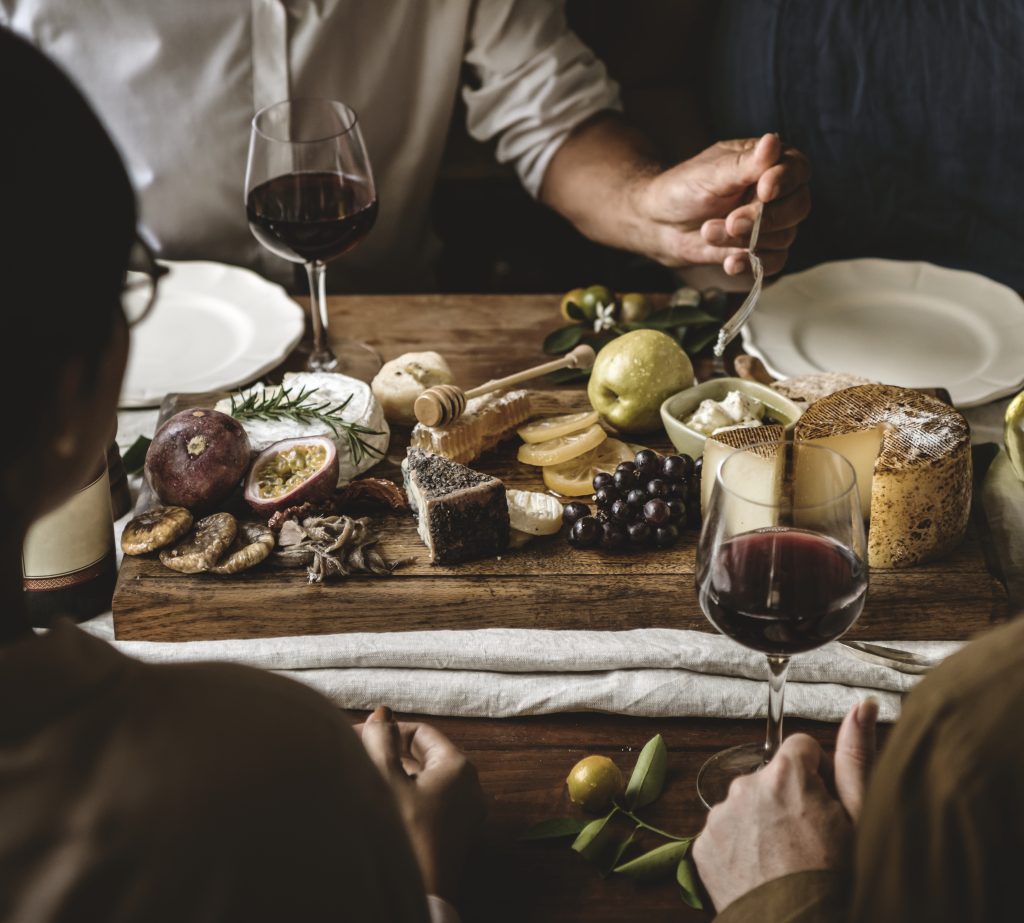Are you a wine enthusiast who loves indulging in a juicy steak or a delicate seafood dish? Well, let us help you take your dining experience to a whole new level! In this article, we will provide you with essential tips on wine and food pairing. Whether you’re planning a fancy dinner or simply want to elevate your everyday meals, understanding the art of pairing wine with food is key. We will explore the historical connections between wine and food, the evolution of wine pairing in fine dining, and different approaches you can take when selecting the perfect wine for your meal. So, get ready to enhance your palate and create unforgettable dining moments. Let’s dive into the world of wine and food pairing together!
Contents
Local Wine and Local Food Pairing
When choosing the best course for pairing wine and food, consider using local wine that is compatible with local food. Regional wine pairings are a great way to enhance the dining experience by highlighting traditional food and wine matches. Indigenous wine and cuisine often share similar flavor profiles, making them a natural pairing. By incorporating local flavors in wine pairing, you can create cultural wine and food combinations that showcase the unique characteristics of a specific region.
For example, in Italy, tomato-based sauces are a staple in many traditional dishes. These sauces pair perfectly with tangy red wines like Chianti, creating a harmonious balance of flavors. In Greece, Assyrtiko is a popular white wine that pairs well with Greek salad, showcasing the indigenous flavors of the region. Argentina is known for its grilled meat dishes, and Malbec is the ideal wine to complement the rich flavors of the meat.
Pairing Wine With Specific Dishes
To enhance your dining experience, consider pairing wine with specific dishes that complement and enhance the flavors of both the food and the wine. When it comes to Thanksgiving dinner, recommended wine pairings include a rich and fruity Pinot Noir for roasted turkey, a buttery Chardonnay for creamy mashed potatoes, and a sweet Riesling for pumpkin pie. For those who enjoy spicy foods, wine pairing suggestions include a refreshing Rosé to balance the heat or a fruity Gewürztraminer to complement the bold flavors. When exploring wine options for creamy pasta dishes, opt for a medium-bodied white wine like a Viognier or a buttery Chardonnay to enhance the richness of the sauce. When it comes to pairing wine with grilled chicken or steak, a full-bodied red wine such as Cabernet Sauvignon or Syrah can stand up to the charred flavors. Finally, for desserts, wine recommendations include a sweet and luscious Port with chocolate cake or a sparkling Moscato d’Asti with fruit tarts. Remember, the key to a successful wine pairing is to experiment and find what suits your taste preferences best. Cheers to a delightful dining experience!
Guidelines for Wine Pairing
Follow these guidelines to enhance your wine pairing experience:
- Wine and dessert pairing: When it comes to pairing wine with desserts, opt for a sweeter wine that complements the sweetness of the dish. For example, a rich and fruity Port or a sweet Riesling can be a perfect match for chocolate-based desserts or fruity desserts like apple pie.
- Pairing wine with vegetarian dishes: Vegetarian dishes offer a wide range of flavors and textures, making them versatile for wine pairing. Consider lighter-bodied wines like Sauvignon Blanc or Pinot Noir for lighter vegetarian meals, while fuller-bodied wines like Cabernet Sauvignon or Syrah can stand up to heartier vegetarian dishes like mushroom risotto or vegetable lasagna.
- Wine pairing for spicy cuisine: Spicy cuisine can be challenging to pair with wine due to the heat and intensity of the flavors. Opt for off-dry or slightly sweet wines like Gewürztraminer or Riesling to balance the heat. Alternatively, sparkling wines like Prosecco or Champagne can provide a refreshing contrast to the spiciness.
- Wine pairing for summer barbecues: For summer barbecues, look for wines that can stand up to the smoky flavors and richness of grilled meats. Choose bold red wines like Zinfandel or Syrah for grilled steaks or ribs, or opt for a chilled and crisp white wine like Sauvignon Blanc or Rosé for grilled seafood or chicken.
- Exploring natural wine pairings: Natural wines, made with minimal intervention and additives, can offer unique flavors and characteristics. Experiment with natural wines and pair them with dishes that highlight their natural and unadulterated qualities. Try pairing an orange wine with roasted vegetables or a funky natural red with charcuterie and cheese.
Exploring Different Wine Regions
Explore the diverse flavors and characteristics of different wine regions around the world. When it comes to wine, there is a whole world to discover beyond just the taste. Each wine region has its own unique terroir, which includes factors like soil types, climate, and grape varietals. These elements contribute to the distinct flavors and aromas found in wines from different regions.
To help you navigate the vast world of wine, here is a table showcasing some well-known wine regions and the types of wine they are famous for:
| Region | Old World vs. New World | Lesser Known Regions |
|---|---|---|
| France | Old World | Jura |
| Italy | Old World | Etna |
| Spain | Old World | Priorat |
| California | New World | Lodi |
| New Zealand | New World | Central Otago |
Exploring wine regions not only allows you to taste different wines but also offers unique experiences. Many wineries offer vineyard experiences, where you can learn about the winemaking process and even participate in grape harvesting. Tasting menus paired with wines are also popular at wineries, where you can indulge in a multi-course meal crafted to complement the wines.
Wine tourism is a growing trend, with wine regions around the world becoming popular destinations for wine tours and tastings. From Napa Valley in California to Tuscany in Italy, these regions offer breathtaking landscapes and opportunities to immerse yourself in the local culture and cuisine.
In addition to visiting wine regions, wine and food festivals are a great way to explore different wine regions and their cuisine. These events showcase regional dishes paired with local wines, allowing you to experience the unique flavors of each region.
Techniques for Successful Wine Pairing
Enhance your dining experience by mastering the techniques for successful wine pairing. Pairing wine with food can elevate the flavors and create a harmonious balance on your palate. Whether you’re enjoying a dessert, vegetarian dish, spicy cuisine, summer BBQ, or Asian cuisine, here are some techniques to help you achieve the perfect pairing:
- Pairing Wine with Desserts: When pairing wine with desserts, consider the level of sweetness in both the wine and the dessert. Opt for a wine that is sweeter than the dessert to avoid overpowering the flavors. For chocolate-based desserts, try a rich and velvety port or a full-bodied red wine like Zinfandel.
- Wine Pairing for Vegetarian Dishes: Vegetarian dishes can be paired with a variety of wines depending on the flavors and ingredients. For lighter dishes like salads or vegetable-based dishes, opt for a crisp and refreshing white wine like Sauvignon Blanc. For heartier vegetarian dishes with rich sauces or mushrooms, a medium-bodied red wine like Pinot Noir or a fruity Gamay can be a great choice.
- Wine Pairing for Spicy Cuisine: Spicy cuisine can be challenging to pair with wine due to the heat and intensity of the flavors. Opt for wines with lower alcohol content, like off-dry Riesling or Gewürztraminer, to help balance the spice. Sparkling wines like Champagne or Prosecco can also provide a refreshing contrast to the heat.
- Wine Pairing for Summer BBQ: Summer BBQs often feature grilled meats, smoky flavors, and tangy sauces. Pair bold and robust red wines like Cabernet Sauvignon or Syrah with grilled steaks or burgers. For lighter fare like grilled chicken or seafood, consider a crisp and citrusy white wine like Sauvignon Blanc or a rosé.
- Wine Pairing for Asian Cuisine: Asian cuisine offers a wide range of flavors, from sweet and sour to spicy and savory. For dishes with sweeter sauces like General Tso’s chicken or sweet and sour pork, opt for a slightly off-dry Riesling or a Gewürztraminer. For spicier dishes like Thai curry or Sichuan-style cuisine, a slightly sweet and fruity red wine like a Beaujolais or a spicy Shiraz can be a great choice.
Wine and Cheese Pairing
When pairing wine with food, one classic combination that often comes to mind is wine and cheese. Wine and cheese pairing has been enjoyed for centuries, with certain combinations becoming classic favorites. Exploring regional wine and cheese pairings is a great way to enhance your culinary experience. Matching wines and cheeses from the same region often leads to a harmonious blend of flavors. The rich history and cultural significance of both wine and cheese often contribute to the development of complementary flavor profiles.
Enhancing flavors with wine and cheese is an art that can be mastered through experimentation. The key is to find the perfect balance between the flavors of the wine and the cheese. By selecting a wine that complements the characteristics of the cheese, you can elevate the taste experience. For example, a bold and robust red wine pairs well with aged cheeses, while a crisp and acidic white wine enhances the creaminess of soft cheeses.
Discovering new wine and cheese combinations is an exciting journey of exploration. With countless varieties of both wine and cheese available, the possibilities are endless. Don’t be afraid to step outside of your comfort zone and try different combinations. You may be pleasantly surprised by the unique flavors that emerge when certain wines are paired with specific cheeses.
Considering Taste Components in Pairing
To create the perfect wine and food pairing, it is important to consider the taste components of both the wine and the food. Identifying taste components allows you to balance flavors, enhance certain components, and simplify dishes to create a harmonious pairing. Here are some tips to keep in mind when considering taste components in pairing:
- Identifying taste components: Take note of the prominent tastes in both the wine and the food. Is the wine acidic, sweet, or bitter? Is the food salty, spicy, or fatty? Understanding these taste components will help you find complementary flavors.
- Balancing flavors: Aim for a balanced pairing by considering the intensity of both the food and the wine. If the dish is highly flavorful, choose a wine that can stand up to it without overpowering. On the other hand, if the dish is delicate, opt for a wine that won’t overwhelm its flavors.
- Enhancing components: Look for ways to enhance the components that both the wine and the food possess. For example, a wine with citrus notes can enhance the flavors of a seafood dish, while a wine with earthy undertones can enhance the flavors of a mushroom-based dish.
- Simplifying dishes: Sometimes, simplifying a dish can make it easier to identify the taste components and find a suitable wine pairing. Removing complex sauces or overpowering spices can help you focus on the core flavors and find a complementary wine.
- Experimenting with pairings: Don’t be afraid to experiment with different pairings to find what works best for you. Taste is subjective, and what may work for one person may not work for another. Trust your palate and have fun exploring different combinations.
The Art of Wine Pairing With Friends and Family
Gather your friends and family for an unforgettable experience as you explore the art of wine pairing. This is an opportunity to not only enjoy great food and wine but also to bond over shared culinary adventures. When pairing wine with friends and family, it’s important to consider everyone’s personal preferences. Encourage everyone to share their favorite wines and recommendations, and be open to trying new flavor combinations. This can lead to exciting discoveries and create memorable experiences.
As you explore different wine pairings, take the time to discuss the cultural influences behind them. Wine has a rich history and is deeply intertwined with the culinary traditions of various regions. By learning about the cultural significance of certain pairings, you can gain a deeper appreciation for the flavors and the stories behind them.
When sharing wine recommendations with friends and family, keep in mind that the goal is to enhance the dining experience. Consider the flavors of the dish and choose wines that will complement and elevate those flavors. Don’t be afraid to experiment and step outside of your comfort zone. Trying new wines and flavor combinations can lead to delightful surprises and expand your understanding of wine pairing.
Ultimately, the art of wine pairing with friends and family is about coming together to enjoy good food, good wine, and good company. It’s a chance to create lasting memories and strengthen relationships. So gather your loved ones, explore your personal preferences, share wine recommendations, try new flavor combinations, and have fun discussing the cultural influences that shape the world of wine pairing. Cheers to unforgettable experiences!




